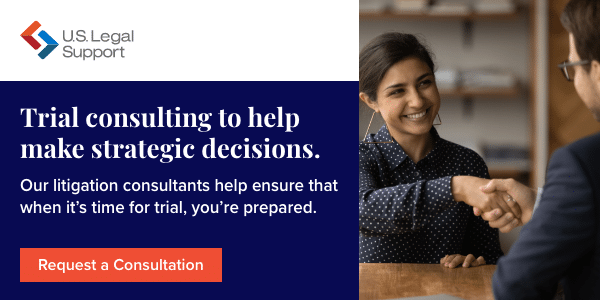Strategies to Overcome Common eDiscovery Challenges

Electronic discovery (eDiscovery) allows attorneys to build cases that require delving into relevant ESI, or electronically stored information, such as emails, audio and video files, and social media, in addition to hard-copy documents. There are tools and technologies—including the emerging use of AI—that tackle eDiscovery. Choosing the right solutions and implementing them can be a complex process in today’s age of big data.
Plus, even the best technology isn’t a magic wand. You’ll need to consider changes to your firm’s legal operations, staff training, and budget to effectively address challenges during the eDiscovery process. When managed effectively, eDiscovery tools—in addition to AI for legal discovery—can be outstanding assets for legal professionals.
Technical Challenges in eDiscovery
The amount of electronic data individuals and entities produce, handle, and share is vast—and, unfortunately, usually a mess. With the growth of cloud storage, electronic communication, and social platforms, finding curated and logically sorted files during discovery is as likely as unicorn-spotting.
Data Volume and Complexity
The first challenge with eDiscovery is the sheer volume of available ESI. The large amount of available information can complicate how your team uses and understands the data, making preparation for proceedings—like a deposition vs. testimony—even more challenging. Everlaw, an eDiscovery provider, saw the number of documents hosted on their platform grow by a whopping 48% in 2022 alone.1 Plus, data volume as an issue is exacerbated by the need to:
- Avoid claims of file tampering by storing originals with metadata intact2
- Convert data to useable formats, which generates more files to store
- Extract, index, database-enter, and manipulate potentially relevant data
Accessing and analyzing ESI is also complex in nature:
- Multiple rounds of tagging, coding, and review are used to identify relevant files
- Many electronic files also include dynamic metadata that requires analysis
- Files may require conversion to static formats to redact privileged information2
- Data is on local and networked devices, private accounts, and gated environments as well as public records and sites, all potentially under differing jurisdictions3
Integration with Existing Systems
Whatever balance you achieve between outsourcing eDiscovery work and investing in solutions to perform it in-house, you’ll want to maximize efficiency and minimize resource drain. For example, consider:
- Initial and ongoing costs (including costs such as IT staffing or upgrading devices)3
- How the solution measures and reports performance and ROI
- How a new process or platform fits with your current workflow and staffing levels
- Whether individual project outsourcing, platform demos, or other trial runs are available
- Availability and quality of training and technical and/or customer support
Legal and Compliance Issues
It’s no longer the case of a missing or forged paper document—eDiscovery multiplies the risks related to protecting and proving the provenance of critical information.
Privacy Laws and Regulations
Protecting private data and adhering to relevant laws and regulations surrounding information governance is a challenge. Consider how data is touched and managed at each step of its retrieval, use, and storage. Ensure your law firm, software, and external partners employ current cybersecurity protocols.
Cross-Border Discovery Concerns
Discovery has always been a challenge when it comes to crossing borders. While electronic data can be more readily transmitted than paper files, you still need to overcome:
- Language issues with trusted translation services
- Knowing what records exist and where when institutions and practices differ
- Identifying the effective protocol for requesting, following up, and securing each file
Strategies for Managing eDiscovery Challenges
You can improve your outcomes by planning ahead, choosing effective solutions for your needs, and establishing and sticking to firm protocols.
Leveraging Advanced Technologies
Understanding what tools and services are available is the first step in using your discovery resources effectively.
Your eDiscovery platform or service should:
- Utilize technology assisted review (TAR) to tag and prioritize ESI with predictive coding3
- Easily convert all file formats to readable data
- Search, track, and report on applications and appeals for ESI across multiple sources
Many eDiscovery platforms also leverage AI to4,5:
- Automate data collection, processing, review, and scoring of data
- Group and organize relevant data conceptually
- Write summaries and create interactive visual charting of documents and data sets
- Identify unusual and interesting patterns and connections within data
- Refine search patterns and results based on human feedback
- Assist in the process of document review
Developing a Comprehensive eDiscovery Plan
Keeping your team on the same page with processes and best practices means prioritizing and documenting your eDiscovery efforts. This includes:
- Know each jurisdiction’s eDiscovery format, storage, and other requirements
- Ensure your staff is and remains fully trained to make the best use of your eDiscovery tools
- Identify case-specific time constraints
- Start eDiscovery early for gated data that require court orders or applications for data
- Autopsy and document your eDiscovery outcomes toward continuous improvement
Work with an Experienced Litigation Support Partner
When it comes to managing all phases of litigation, from discovery through trial, it’s important to work with an experienced litigation support services provider.
U.S. Legal Support has been in business since 1996, supporting attorneys, law firms, legal teams, and other organizations with top-notch services. We provide nationwide court reporting for depositions and other proceedings, records retrieval, analysis, and organization, litigation consulting, interpreting and translation services, remote deposition services, and more — all managed via a fully secure Client Portal.
Reach out today to discuss your discovery and litigation support needs.
Sources:
- Everlaw. New Trends Report Shows Growing “Ediscovery Efficiency Gap”. https://www.everlaw.com/blog/legal-technology/trends-report-highlights-ediscovery-efficiency-gap/
- Complete Discovery Source. The Basics: What is e-Discovery? https://cdslegal.com/knowledge/the-basics-what-is-e-discovery/
- Cloudficient. How To Overcome These 7 eDiscovery Challenges. https://www.cloudficient.com/blog/how-to-overcome-these-7-ediscovery-challenges
- Law.com by ALM Global, LLC. How Agencies, Legal Teams and Corporations Are Safely Using AI for E-Discovery to Reduce Costs and Accelerate Time to Resolution. https://www.law.com/legaltechnews/2023/12/14/how-agencies-legal-teams-and-corporations-are-safely-using-ai-for-e-discovery-to-reduce-costs-and-accelerate-time-to-resolution/
- Deloitte. Artificial intelligence and machine learning in e-discovery and beyond. https://www2.deloitte.com/ch/en/pages/forensics/articles/AI-and-machine-learning-in-E-discovery.html

Editoral Policy
Content published on the U.S. Legal Support blog is reviewed by professionals in the legal and litigation support services field to help ensure accurate information. The information provided in this blog is for informational purposes only and should not be construed as legal advice for attorneys or clients.


